5. v-bind和v-on
绑定属性我们使用v-bind:
[ ] 缩写::
[ ] 预期:any (with argument) | Object (without argument)
[ ] 参数:attrOrProp (optional)
[ ] 修饰符: .camel - 将 kebab-case attribute 名转换为 camelCase。
[ ] 用法:动态地绑定一个或多个 attribute,或一个组件 prop 到表达式。
[ ] v-bind用于绑定一个或多个属性值,或者向另一个组件传递props值;
[ ] 在开发中,有哪些属性需要动态进行绑定呢?
- 比如图片的链接src、网站的链接href、动态绑定一些类、样式等等
绑定基本属性 n v-bind有一个对应的语法糖,也就是简写方式。
在开发中,我们通常会使用语法糖的形式,因 为这样更加简洁
5.1 v-bind的基本使用
示例
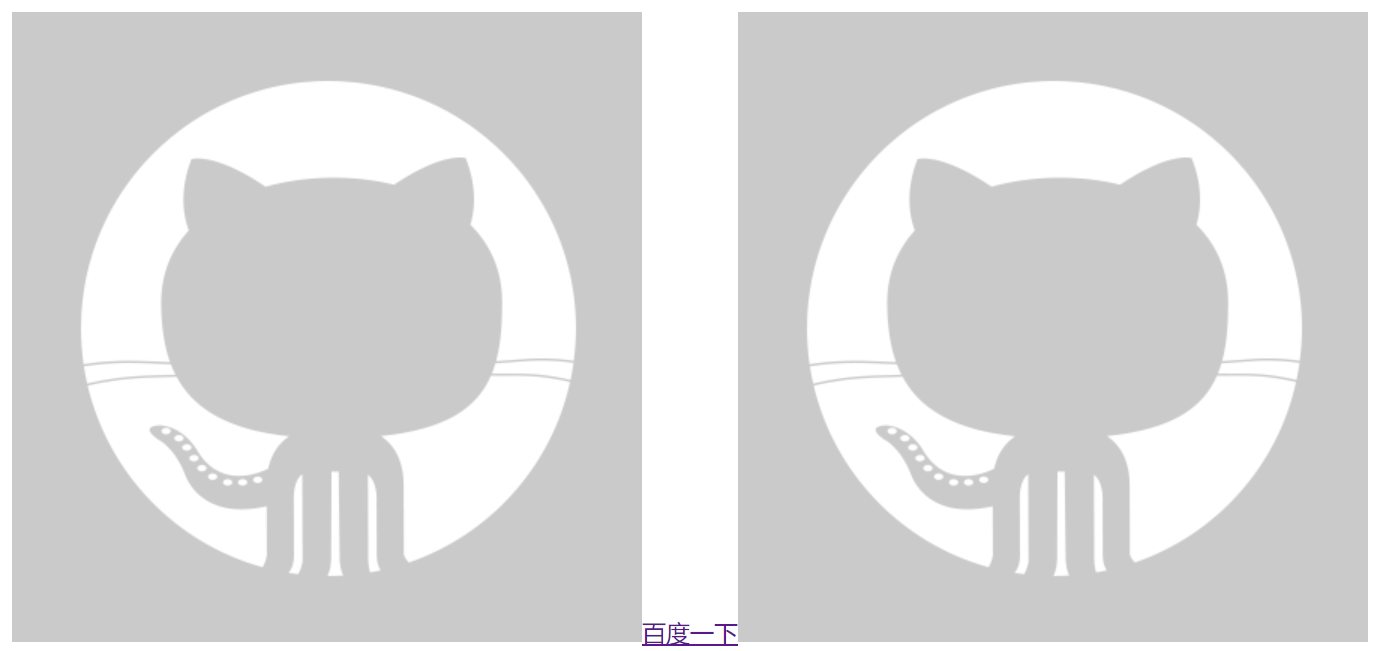
html
<!DOCTYPE html>
<html lang="en">
<head>
<meta charset="UTF-8">
<meta http-equiv="X-UA-Compatible" content="IE=edge">
<meta name="viewport" content="width=device-width, initial-scale=1.0">
<title>Document</title>
</head>
<body>
<div id="app"></div>
<!-- vue2 template模板中只能有一个根元素 -->
<!-- vue3 是允许template中有多个根元素 -->
<template id="my-app">
<!-- 1.v-bind的基本使用 -->
<img v-bind:src="imgUrl" alt="">
<a v-bind:href="link">百度一下</a>
<!-- 2.v-bind提供一个语法糖 : -->
<img :src="imgUrl" alt="">
<img src="imgUrl" alt="">
</template>
<script src="../js/vue.js"></script>
<script>
const App = {
template: '#my-app',
data() {
return {
imgUrl: "https://avatars.githubusercontent.com/u/66?s=60&v=4",
link: "https://www.baidu.com"
}
}
}
Vue.createApp(App).mount('#app');
</script>
</body>
</html>5.2 v-bind绑定class-对象语法
对象语法:我们可以给 :class (v-bind:class 的缩写) 传递一个对象来动态切换 class:
示例
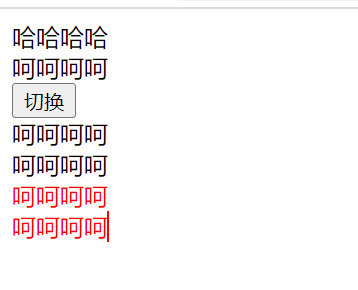
html
<!DOCTYPE html>
<html lang="en">
<head>
<meta charset="UTF-8" />
<meta http-equiv="X-UA-Compatible" content="IE=edge" />
<meta name="viewport" content="width=device-width, initial-scale=1.0" />
<title>Document</title>
<style>
.active {
color: red;
}
</style>
</head>
<body>
<div id="app"></div>
<template id="my-app">
<div :class="className">哈哈哈哈</div>
<!-- 对象语法: {'active': boolean} -->
<div :class="{'active': isActive}">呵呵呵呵</div>
<button @click="toggle">切换</button>
<!-- 也可以有多个键值对 -->
<div :class="{active: isActive, title: true}">呵呵呵呵</div>
<!-- 默认的class和动态的class结合 -->
<div class="abc cba" :class="{active: isActive, title: true}">
呵呵呵呵
</div>
<!-- 将对象放到一个单独的属性中 -->
<div class="abc cba" :class="classObj">呵呵呵呵</div>
<!-- 将返回的对象放到一个methods(computed)方法中 -->
<div class="abc cba" :class="getClassObj()">呵呵呵呵</div>
</template>
<script src="../js/vue.js"></script>
<script>
const App = {
template: "#my-app",
data() {
return {
className: "why",
isActive: true,
title: "abc",
classObj: {
active: true,
title: true
},
};
},
methods: {
toggle() {
this.isActive = !this.isActive;
},
getClassObj() {
return {
active: true,
title: true
}
}
},
};
Vue.createApp(App).mount("#app");
</script>
</body>
</html>5.3 v-bind绑定class-数组语法
数组语法:我们可以把一个数组传给 :class,以应用一个 class 列表;
示例
html
<!DOCTYPE html>
<html lang="en">
<head>
<meta charset="UTF-8">
<meta http-equiv="X-UA-Compatible" content="IE=edge">
<meta name="viewport" content="width=device-width, initial-scale=1.0">
<title>Document</title>
</head>
<body>
<div id="app"></div>
<template id="my-app">
<div :class="['abc', title]">哈哈哈哈</div>
<div :class="['abc', title, isActive ? 'active': '']">哈哈哈哈</div>
<div :class="['abc', title, {active: isActive}]">哈哈哈哈</div>
</template>
<script src="../js/vue.js"></script>
<script>
const App = {
template: '#my-app',
data() {
return {
message: "Hello World",
title: "cba",
isActive: true
}
}
}
Vue.createApp(App).mount('#app');
</script>
</body>
</html>5.4 v-bind绑定style-对象语法
:style支持绑定 JavaScript 对象值,对应的是 HTML 元素的style属性::style支持绑定 CSS property 名可以用驼峰式 (camelCase) 或短横线分隔 (kebab-case,记得用引号括起来) 来命名;
示例
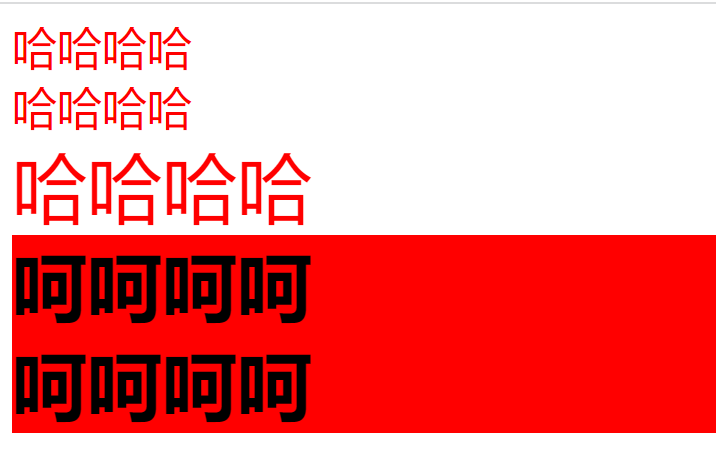
html
<!DOCTYPE html>
<html lang="en">
<head>
<meta charset="UTF-8">
<meta http-equiv="X-UA-Compatible" content="IE=edge">
<meta name="viewport" content="width=device-width, initial-scale=1.0">
<title>Document</title>
</head>
<body>
<div id="app"></div>
<template id="my-app">
<!-- :style="{cssPropertyName: cssPropertyValue}" -->
<div :style="{color: finalColor, 'font-size': '30px'}">哈哈哈哈</div>
<div :style="{color: finalColor, fontSize: '30px'}">哈哈哈哈</div>
<div :style="{color: finalColor, fontSize: finalFontSize + 'px'}">哈哈哈哈</div>
<!-- 绑定一个data中的属性值, 并且是一个对象 -->
<div :style="finalStyleObj">呵呵呵呵</div>
<!-- 调用一个方法 -->
<div :style="getFinalStyleObj()">呵呵呵呵</div>
</template>
<script src="../js/vue.js"></script>
<script>
const App = {
template: '#my-app',
data() {
return {
message: "Hello World",
finalColor: 'red',
finalFontSize: 50,
finalStyleObj: {
'font-size': '50px',
fontWeight: 700,
backgroundColor: 'red'
}
}
},
methods: {
getFinalStyleObj() {
return {
'font-size': '50px',
fontWeight: 700,
backgroundColor: 'red'
}
}
}
}
Vue.createApp(App).mount('#app');
</script>
</body>
</html>5.5 v-bind绑定style-数组语法
:style 的数组语法可以将多个样式对象应用到同一个元素上;
示例
html
<!DOCTYPE html>
<html lang="en">
<head>
<meta charset="UTF-8">
<meta http-equiv="X-UA-Compatible" content="IE=edge">
<meta name="viewport" content="width=device-width, initial-scale=1.0">
<title>Document</title>
</head>
<body>
<div id="app"></div>
<template id="my-app">
<div :style="[style1Obj, style2Obj]">哈哈哈</div>
<img :src="" alt="">
<a :href=""></a>
<div :class></div>
</template>
<script src="../js/vue.js"></script>
<script>
const App = {
template: '#my-app',
data() {
return {
message: "Hello World",
style1Obj: {
color: 'red',
fontSize: '30px'
},
style2Obj: {
textDecoration: "underline"
}
}
}
}
Vue.createApp(App).mount('#app');
</script>
</body>
</html>5.6 v-bind动态绑定属性 名称
- 在某些情况下,我们属性的名称可能也不是固定的:
- [ ] 前端我们无论绑定src、href、class、style,属性名称都是固定的;
- [ ] 如果属性名称不是固定的,我们可以使用 :[属性名]=“值” 的格式来定义;
- [ ] 这种绑定的方式,我们称之为动态绑定属性
示例
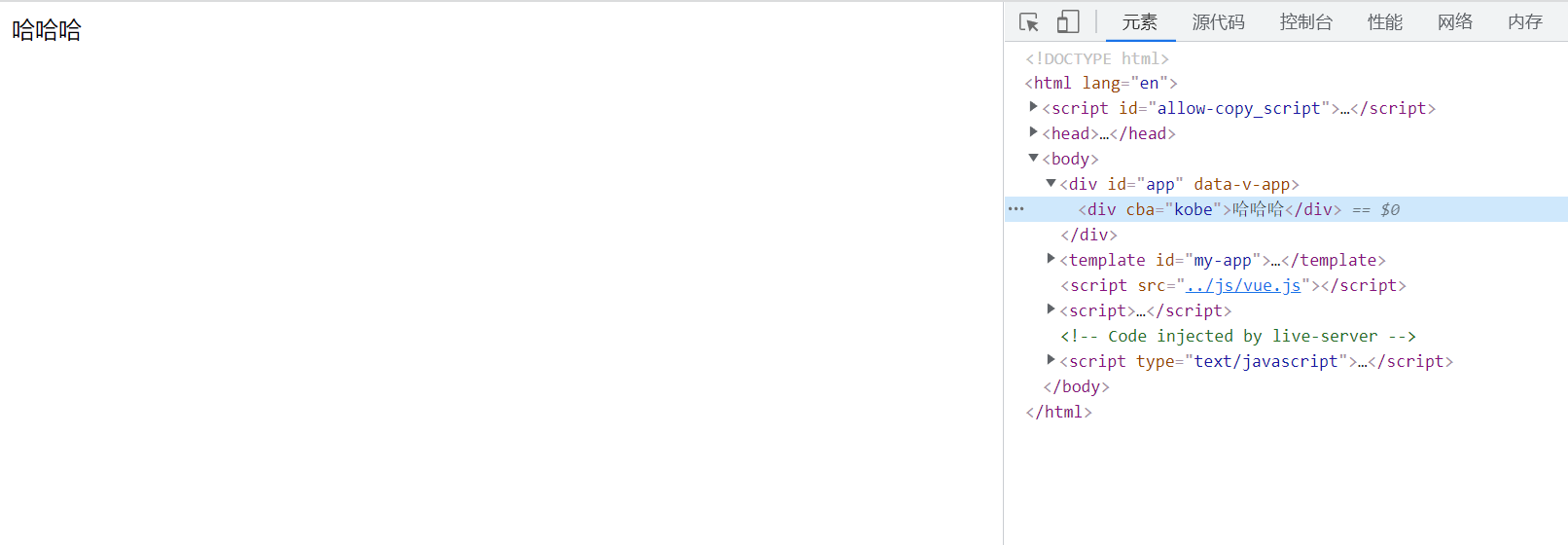
html
<!DOCTYPE html>
<html lang="en">
<head>
<meta charset="UTF-8">
<meta http-equiv="X-UA-Compatible" content="IE=edge">
<meta name="viewport" content="width=device-width, initial-scale=1.0">
<title>Document</title>
</head>
<body>
<div id="app"></div>
<template id="my-app">
<div :[name]="value">哈哈哈</div>
</template>
<script src="../js/vue.js"></script>
<script>
const App = {
template: '#my-app',
data() {
return {
name: "cba",
value: "kobe"
}
}
}
Vue.createApp(App).mount('#app');
</script>
</body>
</html>5.7 v-bind属性直接绑定一个对象
直接使用 v-bind 绑定一个 对象;
示例

html
<!DOCTYPE html>
<html lang="en">
<head>
<meta charset="UTF-8">
<meta http-equiv="X-UA-Compatible" content="IE=edge">
<meta name="viewport" content="width=device-width, initial-scale=1.0">
<title>Document</title>
</head>
<body>
<div id="app"></div>
<template id="my-app">
<div v-bind="info">哈哈哈哈</div>
<div :="info">哈哈哈哈</div>
</template>
<script src="../js/vue.js"></script>
<script>
const App = {
template: '#my-app',
data() {
return {
info: {
name: "why",
age: 18,
height: 1.88
}
}
}
}
Vue.createApp(App).mount('#app');
</script>
</body>
</html>5.8 v-on的用法
v-on的使用:
[ ] 缩写:@
[ ] 预期:Function | Inline Statement | Object
[ ] 参数:event
[ ] 修饰符:
- .stop - 调用 event.stopPropagation()。
- .prevent - 调用 event.preventDefault()。
- .capture - 添加事件侦听器时使用 capture 模式。
- .self - 只当事件是从侦听器绑定的元素本身触发时才触发回调。
- .{keyAlias} - 仅当事件是从特定键触发时才触发回调。
- .once - 只触发一次回调。 ü
- .left - 只当点击鼠标左键时触发。
- .right - 只当点击鼠标右键时触发。
- .middle - 只当点击鼠标中键时触发。
- .passive - { passive: true } 模式添加侦听器
用法:绑定事件监听
5.9 v-on的基本使用
- 用v-on来监听一下点击的事件
- v-on:click可以写成@click,是它的语法糖写法:
- 当然,我们也可以绑定其他的事件:
- 如果我们希望一个元素绑定多个事件,这个时候可以传入一个对象:
示例
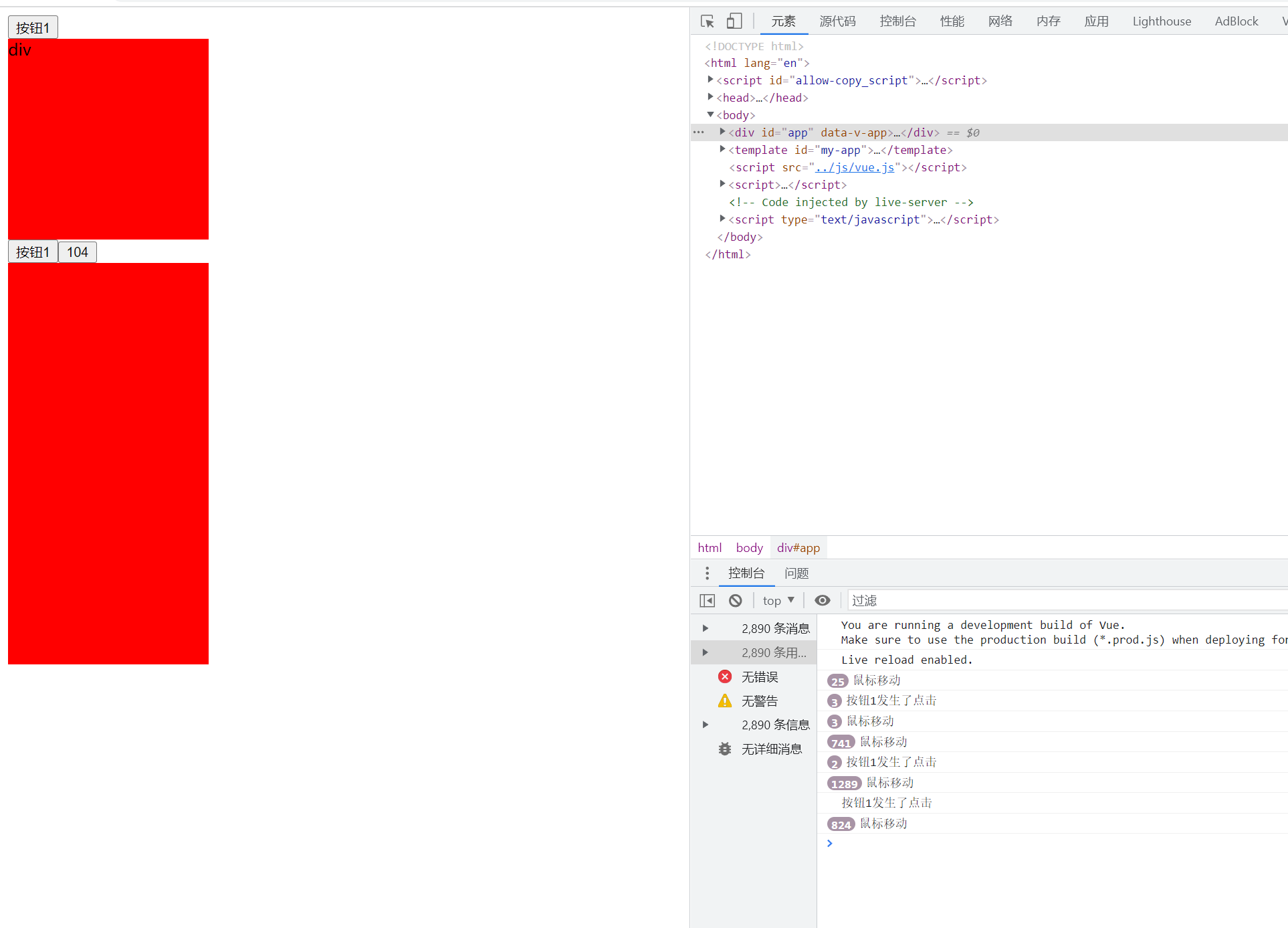
html
<!DOCTYPE html>
<html lang="en">
<head>
<meta charset="UTF-8">
<meta http-equiv="X-UA-Compatible" content="IE=edge">
<meta name="viewport" content="width=device-width, initial-scale=1.0">
<title>Document</title>
<style>
.area {
width: 200px;
height: 200px;
background: red;
}
</style>
</head>
<body>
<div id="app"></div>
<template id="my-app">
<!-- 完整写法: v-on:监听的事件="methods中方法" -->
<button v-on:click="btn1Click">按钮1</button>
<div class="area" v-on:mousemove="mouseMove">div</div>
<!-- 语法糖 -->
<button @click="btn1Click">按钮1</button>
<!-- 绑定一个表达式: inline statement -->
<button @click="counter++">{{counter}}</button>
<!-- 绑定一个对象 -->
<div class="area" v-on="{click: btn1Click, mousemove: mouseMove}"></div>
<div class="area" @="{click: btn1Click, mousemove: mouseMove}"></div>
</template>
<script src="../js/vue.js"></script>
<script>
const App = {
template: '#my-app',
data() {
return {
message: "Hello World",
counter: 100
}
},
methods: {
btn1Click() {
console.log("按钮1发生了点击");
},
mouseMove() {
console.log("鼠标移动");
}
}
}
Vue.createApp(App).mount('#app');
</script>
</body>
</html>5.10 v-on的参数传递
- 当通过methods中定义方法,以供@click调用时,需要注意参数问题:
- 情况一:如果该方法不需要额外参数,那么方法后的()可以不添加。
- 但是注意:如果方法本身中有一个参数,那么会默认将原生事件event参数传递进去
- 情况二:如果需要同时传入某个参数,同时需要event时,可以通过$event传入事件。
示例
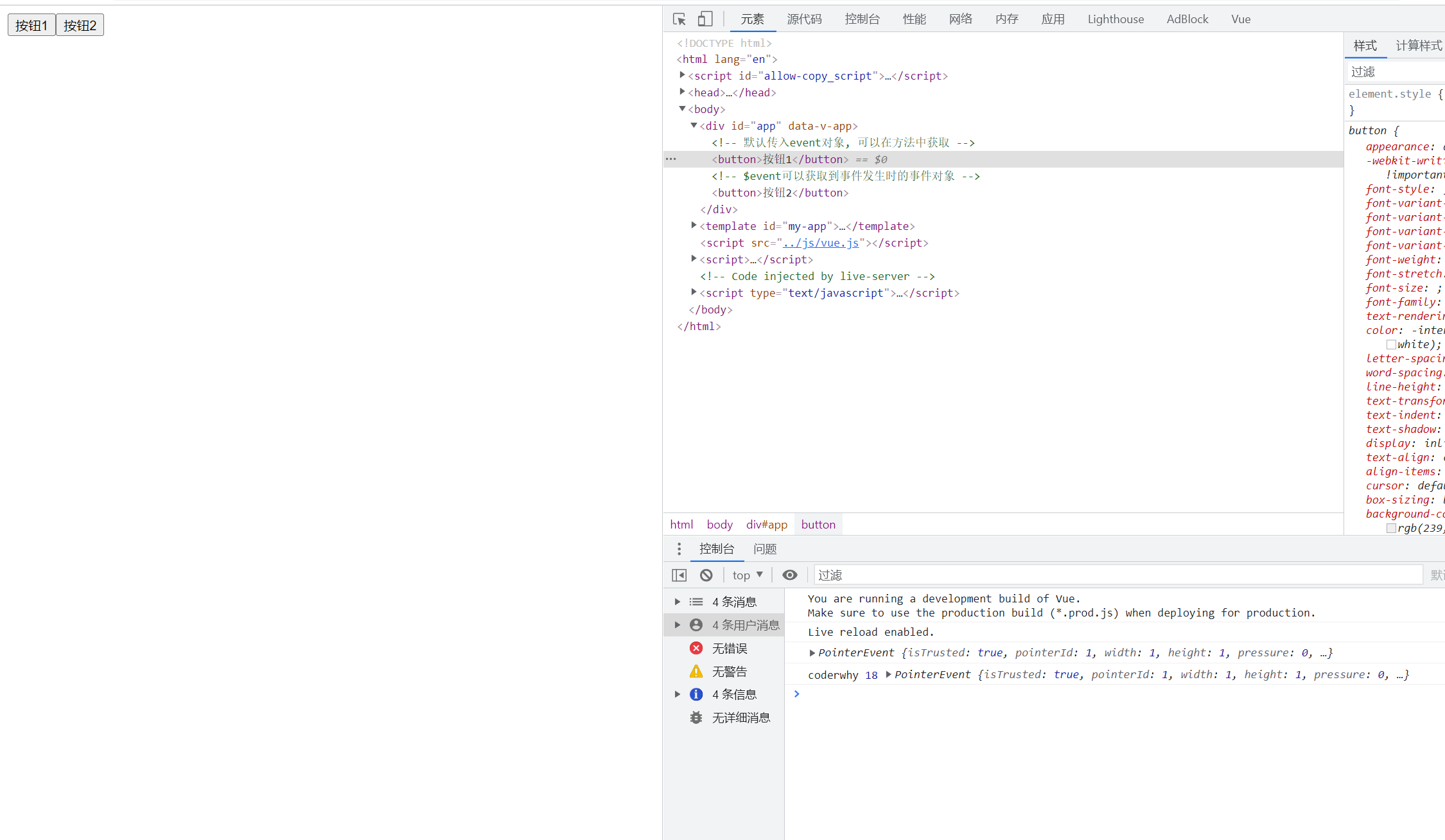
html
<!DOCTYPE html>
<html lang="en">
<head>
<meta charset="UTF-8">
<meta http-equiv="X-UA-Compatible" content="IE=edge">
<meta name="viewport" content="width=device-width, initial-scale=1.0">
<title>Document</title>
</head>
<body>
<div id="app"></div>
<template id="my-app">
<!-- 默认传入event对象, 可以在方法中获取 -->
<button @click="btn1Click">按钮1</button>
<!-- $event可以获取到事件发生时的事件对象 -->
<button @click="btn2Click($event, 'coderwhy', 18)">按钮2</button>
</template>
<script src="../js/vue.js"></script>
<script>
const App = {
template: '#my-app',
data() {
return {
message: "Hello World"
}
},
methods: {
btn1Click(event) {
console.log(event);
},
btn2Click(event, name, age) {
console.log(name, age, event);
}
}
}
Vue.createApp(App).mount('#app');
</script>
</body>
</html>5.11 v-on的修饰符
- v-on支持修饰符,修饰符相当于对事件进行了一些特殊的处理:
- [ ] .stop - 调用 event.stopPropagation()。
- [ ] .prevent - 调用 event.preventDefault()。
- [ ] .capture - 添加事件侦听器时使用 capture 模式。
- [ ] .self - 只当事件是从侦听器绑定的元素本身触发时才触发回调。
- [ ] .{keyAlias} - 仅当事件是从特定键触发时才触发回调。
- [ ] .once - 只触发一次回调。
- [ ] .left - 只当点击鼠标左键时触发。
- [ ] .right - 只当点击鼠标右键时触发。
- [ ] .middle - 只当点击鼠标中键时触发。
- [ ] .passive - { passive: true } 模式添加侦听器
示例
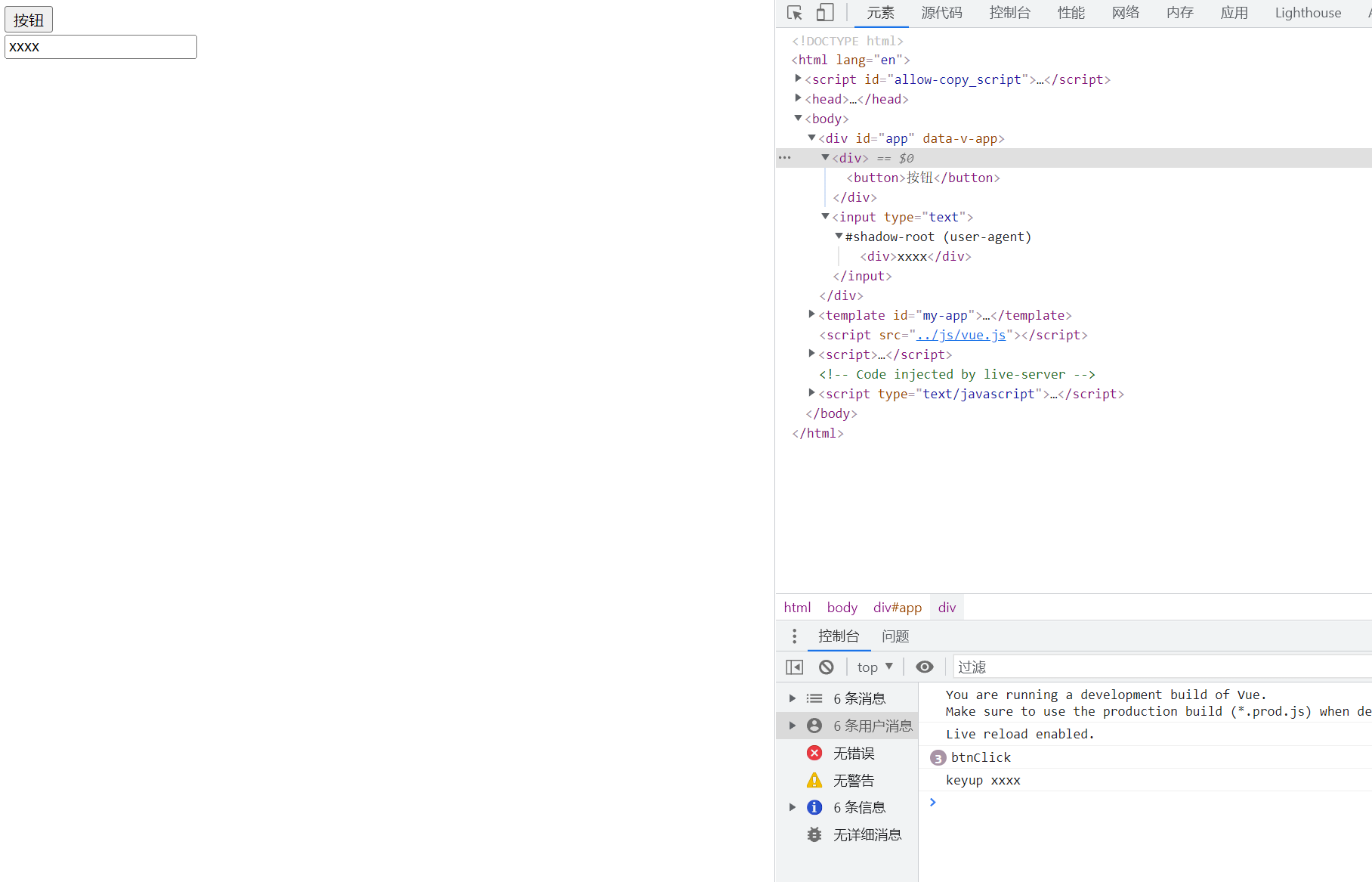
html
<!DOCTYPE html>
<html lang="en">
<head>
<meta charset="UTF-8">
<meta http-equiv="X-UA-Compatible" content="IE=edge">
<meta name="viewport" content="width=device-width, initial-scale=1.0">
<title>Document</title>
</head>
<body>
<div id="app"></div>
<template id="my-app">
<div @click="divClick">
<button @click.stop="btnClick">按钮</button>
</div>
<input type="text" @keyup.enter="enterKeyup">
</template>
<script src="../js/vue.js"></script>
<script>
const App = {
template: '#my-app',
data() {
return {
message: "Hello World"
}
},
methods: {
divClick() {
console.log("divClick");
},
btnClick() {
console.log('btnClick');
},
enterKeyup(event) {
console.log("keyup", event.target.value);
}
}
}
Vue.createApp(App).mount('#app');
</script>
</body>
</html>